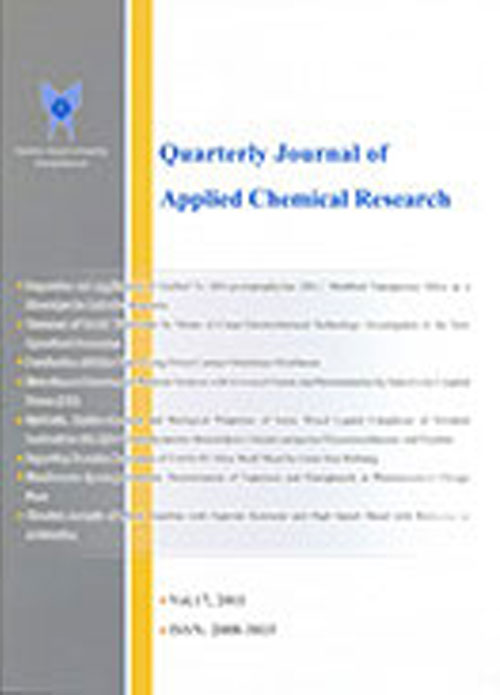فهرست مطالب

Journal of Applied Chemical Research
Volume:16 Issue: 2, Spring 2022
- تاریخ انتشار: 1401/04/26
- تعداد عناوین: 6
-
-
Pages 8-18
In this study, we used the computational process by DFT with the B3LYP/6-311+G (d, p) quantum method to discover the reactivity properties and dope and determine the adsorption behavior of Citalopram on C60 (ih) as anti-depression drug carriers in the gas phase. We calculated chemical structural parameters such as dipole momentum) 3.7193D) and electronic parameters (σ(6.45), µ(-2.70), ω(16.5), χ(2.70) and η(1.53)) which can determine the chemical reactivity of Citalopram. According to the calculated HOMO(-4.25eV) and LUMO(-1.15eV) energy value, Citalopram is a stable and chemical active compound and has chemical reactivity. It has six active sides, which lead to adsorb on C60 nanocage as a drug carrier. This Surface adsorption helps Citalopram transfer to biological systems much better.
Keywords: DFT, Buckyball, Reactivity, Stability -
Pages 19-30
An efficient and environmentally adapted synthesis of 2-amino-3-phenylsulfonyl-4-aryl-4H-benzo[h]chromenderivatives by condensation of a wide range of aryl aldehydes, α-naphthol and (phenylsulfonyl)acetonitrile using a catalytic amount of nano-ZnOunder solvent-free condition is explained. This catalyst was characterized by scanning electron microscopy (SEM), fourier transform infrared spectroscopy (FT-IR),X-ray diffraction spectroscopy (EDX)and Thermogravimetric analysis (TG).As aresult, 2-amino-3-phenylsulfonyl-4-aryl-4H-benzo[h]chromens were produced under facile conditions in high yield (89-96%) and high rate (8-15 min) using nano-ZnO as a recyclable catalyst.
Keywords: Nano-ZnO, Nanocatalyst, α-Naphthol, (Phenylsulfonyl)acetonitrile, Solid acid -
Pages 31-47
An organic–inorganic hybrid nanocomposite was prepared by immobilizing β-cyclodextrin (β-CD) and amino groups onto mesoporous MCM-41 via surfactant-templated sol-gel procedure and post-modification method. The heterogeneous hybrid nanocomposite, MCM-41-β-CD/NH2, was characterized by SEM, TEM, XRD, TGA, BET and FT-IR. The potential application of this covalently linked basic catalyst was also investigated as an efficient, heterogeneous and recyclable stationary micro-vessel and basic heterogeneous catalyst in Biginelli multicomponent condensation reaction. High yield, high efficiency and reusability are among the advantages of this environmentally friendly method. The nano catalyst can be easily separated from the reaction mixture and reused after washing for several runs without less in activity.
Keywords: MCM-41-β-CD, NH2, heterogeneous catalyst, β-cyclodextrin (β-CD), Biginelli reaction -
Pages 48-55
In this work, the discrete dipole approximations (DDA) theorywas used to investigate the absorption spectrum of annealed Zn nano rods in oxygen flux. For this purpose, the Zn nanorod was replaced with 1786 dipoles arranged on a rod-shaped structure, and the interaction of these dipoles with polarized light was investigated. In this study, it was found that the extinction spectrum has two absorption peaks, which are related to the plasmonic oscillations, and Zn nanorods annealed in oxygen flux show metallic behavior. Changes in plasmonic oscillations were investigated by changing the deposition angle of nanorods and it was found that the oscillations in the direction perpendicular to the axis of the nanorod are strongly dependent on the angle of deposition and with increasing deposition angle, the number of oscillating dipoles and consequently the intensity of the absorption decreases sharply.
Keywords: ZnO, Nano rod, Optical spectra, extinction spectra, DDA -
Pages 56-71
The utility of carbon as the base material for carbon paste electrodes has been considered for many years. In this work, we were applied MWCNT as a modifier and Schiff base chitosan and 5-nitro isatin as ionophore along with carbon. Prepared CPE shows a Nernstian response of 29.567 mV per decade in a wide linear dynamic range of 1.0 × 10-5 to 1.0 ×10-1 M for Mg2+ ion. The optimization process had performed by Mixture design in design expert software. This present sensor has a short time of response of about 10 s. The applicable pH range was obtained 3.51-9.0 and Detection limit was calculated 1.4 ×10-5 M. Lastly, the prepared sensor was used in the indirect potentiometry (potentiometric titration) as an indicator or working electrode. The data obtained from the experiments showed that the electrode is usable in analytical applications.
Keywords: Mg2+ ion, Potentiometry, Experimental design, Mixture design, Carbon paste electrode (CPE), D-optimal. -
Pages 72-85
Dopamine (DA) is a well-known neurotransmitter in the brain that is related to mental and motivational states. So, its measurement is essential. A sensitive electrochemical molecularly imprinted sensor-based new nanocomposite was developed for the detection of DA. The structural basis of nanocomposite was composed of molecularly imprinted polymer (MIP) polymerization of methacrylic acid (MAA) in the presence of DA as a template molecule. The MIP was decorated with Fe3O4 particles, ionic liquid (IL), and gold nanoparticles (AuNPs). MIP modified nanocomposite was used as the main component of the carbon paste electrode (CPE). The morphology of the designed nanocomposite was studied by scanning electron microscope (SEM), and Fourier transforms infrared spectroscopy (FT-IR) techniques. The performance of the developed sensor was investigated by cyclic voltammetry (CV), and differential pulse voltammetry (DPV) techniques for the detection of DA. The MIP sensor exhibits a broad linear range, between 6×10-8 to 1×10-5 M and a limit of detection of 1×10-10 M (S/N=3). Furthermore, the modified MIP sensor was successfully employed to test DA in urine and blood samples.
Keywords: Molecularly imprinted polymer, Magnetic graphene oxide, Gold nanoparticles, Electrochemical sensor


